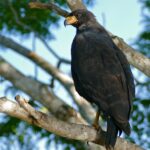The Great Black Hawk (Buteogallus urubitinga) is a large bird of prey found primarily in the Neotropics, including South America, Central America, Mexico, Trinidad, and Tobago. This species is known for its sluggish and slow-moving behavior and is often found near forest edges, bodies of water, savannas, pastures, and fields.
Preferred Habitat of the Great Black Hawk
The Great Black Hawk is an inland bird that prefers to live in forests and open woodlands near water sources. They are often seen near:
- Lakes
- Large ponds
- Palm swamps
- Rivers
- Streams
- Marshes
- Savannas
- Pastures
- Fields
These birds build their platform nests made of sticks high up in emergent trees or on power poles, usually near forest edges and bodies of water.
Behavior and Adaptations in the Habitat
 Image source: Great Black Hawk by Bernard DUPONT
Image source: Great Black Hawk by Bernard DUPONT
The Great Black Hawk is known for its sluggish and slow-moving behavior, often perching or hunting near forest edges and bodies of water. They are also known for their soaring flights, often seen gliding above woodlands and along Amazon rivers.
This species is not a migrant and stays in its native home ranges all year round, adapting to the local environment and resources.
Dietary Preferences in the Habitat
The Great Black Hawk feeds mainly on:
- Reptiles
- Other small vertebrates
- Large insects
They often hunt on foot, and along Amazon rivers, they have been observed raiding hoatzin nesting colonies, looking for eggs and chicks.
Nesting and Reproduction in the Habitat
Great Black Hawks build a large stick nest in a tree and usually lay one dark-blotched whitish egg. The eggs must be incubated for between 35-37 days, and after the nestling hatches, it will grow quickly. The male will work hard to bring enough food to the nest for the female and his offspring.
Conservation Concerns in the Habitat
The Great Black Hawk is currently listed as a species of least concern (LC) by the International Union for Conservation of Nature (IUCN). However, like many bird species, the Great Black Hawk faces threats from:
- Habitat loss
- Pollution
- Climate change
Maintaining the integrity of the Great Black Hawk’s preferred habitats, such as forests, woodlands, and wetlands, is crucial for the conservation of this species.
Conclusion
The Great Black Hawk is a fascinating bird of prey that thrives in the diverse habitats of the Neotropics, including forests, woodlands, and wetlands near water sources. Understanding the specific habitat requirements and adaptations of this species is essential for its long-term conservation.
References:
– Great Black Hawk | The Peregrine Fund. (n.d.). Retrieved April 29, 2024, from https://peregrinefund.org/explore-raptors-species/hawks/great-black-hawk
– Great Black Hawk – Buteogallus urubitinga – Birds of the World. (n.d.). Retrieved April 29, 2024, from https://birdsoftheworld.org/bow/species/grbhaw1/cur/introduction
– Global Raptor Information Network. (2021). Species account: Great Black Hawk Buteogallus urubitinga. Downloaded from http://www.globalraptors.org on 6 Sep. 2021
– Animalia. (n.d.). Great black hawk – Facts, Diet, Habitat & Pictures on Animalia.bio. Retrieved April 29, 2024, from https://animalia.bio/great-black-hawk
– All About Birds. (n.d.). Common Black Hawk – All About Birds. Retrieved April 29, 2024, from https://www.allaboutbirds.org/guide/Common_Black_Hawk/overview
– Oiseaux-Birds. (n.d.). Great Black Hawk – Oiseaux-Birds. Retrieved April 29, 2024, from https://www.oiseaux-birds.com/card-great-black-hawk.html


